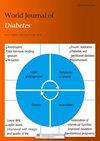Atorvastatin ameliorated myocardial fibrosis in db/db mice by inhibiting oxidative stress and modulating macrophage polarization
IF 4.2
3区 医学
Q1 ENDOCRINOLOGY & METABOLISM
引用次数: 0
Abstract
BACKGROUND People with diabetes mellitus (DM) suffer from multiple chronic complications due to sustained hyperglycemia, especially diabetic cardiomyopathy (DCM). Oxidative stress and inflammatory cells play crucial roles in the occurrence and progression of myocardial remodeling. Macrophages polarize to two distinct phenotypes: M1 and M2, and such plasticity in phenotypes provide macrophages various biological functions. AIM To investigate the effect of atorvastatin on cardiac function of DCM in db/db mice and its underlying mechanisms. METHODS DCM mouse models were established and randomly divided into DM, atorvastatin, and metformin groups. C57BL/6 mice were used as the control. Cardiac function was evaluated by echocardiography. Hematoxylin and eosin and Masson staining was used to examine the morphology and collagen fibers in myocardial tissues. The expression of transforming growth factor-β1 (TGF-β1), tumor necrosis factor-α (TNF-α), interleukin-1 β (IL-1β),M1 macrophages (iNOS+), and M2 macrophages (CD206+) were demonstrated by immunohistochemistry and immunofluorescence staining. The levels of TGF-β1, IL-1β, and TNF-α were detected by ELISA and real-time quantitative polymerase chain reaction. Malondialdehyde (MDA) concentrations and superoxide dismutase (SOD) ac-tivities were also measured. RESULTS Treatment with atorvastatin alleviated cardiac dysfunction and decreased db/db mice. The broken myocardial fibers and deposition of collagen in the myocardial interstitium were relieved especially by atorvastatin treatment. Atorvastatin also reduced the levels of serum lactate dehydrogenase, creatine kinase isoenzyme, and troponin; lowered the levels of TGF-β1, TNF-α and IL-1β in serum and myocardium; decreased the concentration of MDA and increased SOD activity in myocardium of db/db mice; inhibited M1 macrophages; and promoted M2 macrophages. CONCLUSION Administration of atorvastatin attenuates myocardial fibrosis in db/db mice, which may be associated with the antioxidative stress and anti-inflammatory effects of atorvastatin on diabetic myocardium through modulating macrophage polarization.阿托伐他汀通过抑制氧化应激和调节巨噬细胞极化改善 db/db 小鼠的心肌纤维化
背景糖尿病(DM)患者因持续高血糖而患有多种慢性并发症,尤其是糖尿病心肌病(DCM)。氧化应激和炎症细胞在心肌重塑的发生和发展中起着至关重要的作用。巨噬细胞极化为两种不同的表型:这种表型的可塑性为巨噬细胞提供了多种生物学功能。目的 探讨阿托伐他汀对 db/db DCM 小鼠心脏功能的影响及其内在机制。方法 建立 DCM 小鼠模型,随机分为 DM 组、阿托伐他汀组和二甲双胍组。C57BL/6 小鼠为对照组。通过超声心动图评估心脏功能。采用苏木精和Masson染色法检查心肌组织的形态和胶原纤维。免疫组织化学和免疫荧光染色显示了转化生长因子-β1(TGF-β1)、肿瘤坏死因子-α(TNF-α)、白细胞介素-1 β(IL-1β)、M1 巨噬细胞(iNOS+)和 M2 巨噬细胞(CD206+)的表达。TGF-β1、IL-1β 和 TNF-α 的水平通过 ELISA 和实时定量聚合酶链反应进行检测。此外,还测定了丙二醛(MDA)浓度和超氧化物歧化酶(SOD)活性。结果 阿托伐他汀能缓解心功能不全,并降低 db/db 小鼠的心功能。心肌纤维断裂和心肌间质胶原沉积的情况在阿托伐他汀治疗后尤其得到缓解。阿托伐他汀还降低了血清乳酸脱氢酶、肌酸激酶同工酶和肌钙蛋白的水平;降低了血清和心肌中 TGF-β1、TNF-α 和 IL-1β 的水平;降低了 MDA 的浓度,提高了 db/db 小鼠心肌中 SOD 的活性;抑制了 M1 巨噬细胞,促进了 M2 巨噬细胞。结论 服用阿托伐他汀可减轻db/db小鼠心肌纤维化,这可能与阿托伐他汀通过调节巨噬细胞极化对糖尿病心肌的抗氧化和抗炎作用有关。
本文章由计算机程序翻译,如有差异,请以英文原文为准。
求助全文
约1分钟内获得全文
求助全文
来源期刊

World Journal of Diabetes
ENDOCRINOLOGY & METABOLISM-
自引率
2.40%
发文量
909
期刊介绍:
The WJD is a high-quality, peer reviewed, open-access journal. The primary task of WJD is to rapidly publish high-quality original articles, reviews, editorials, and case reports in the field of diabetes. In order to promote productive academic communication, the peer review process for the WJD is transparent; to this end, all published manuscripts are accompanied by the anonymized reviewers’ comments as well as the authors’ responses. The primary aims of the WJD are to improve diagnostic, therapeutic and preventive modalities and the skills of clinicians and to guide clinical practice in diabetes. Scope: Diabetes Complications, Experimental Diabetes Mellitus, Type 1 Diabetes Mellitus, Type 2 Diabetes Mellitus, Diabetes, Gestational, Diabetic Angiopathies, Diabetic Cardiomyopathies, Diabetic Coma, Diabetic Ketoacidosis, Diabetic Nephropathies, Diabetic Neuropathies, Donohue Syndrome, Fetal Macrosomia, and Prediabetic State.
 求助内容:
求助内容: 应助结果提醒方式:
应助结果提醒方式:


